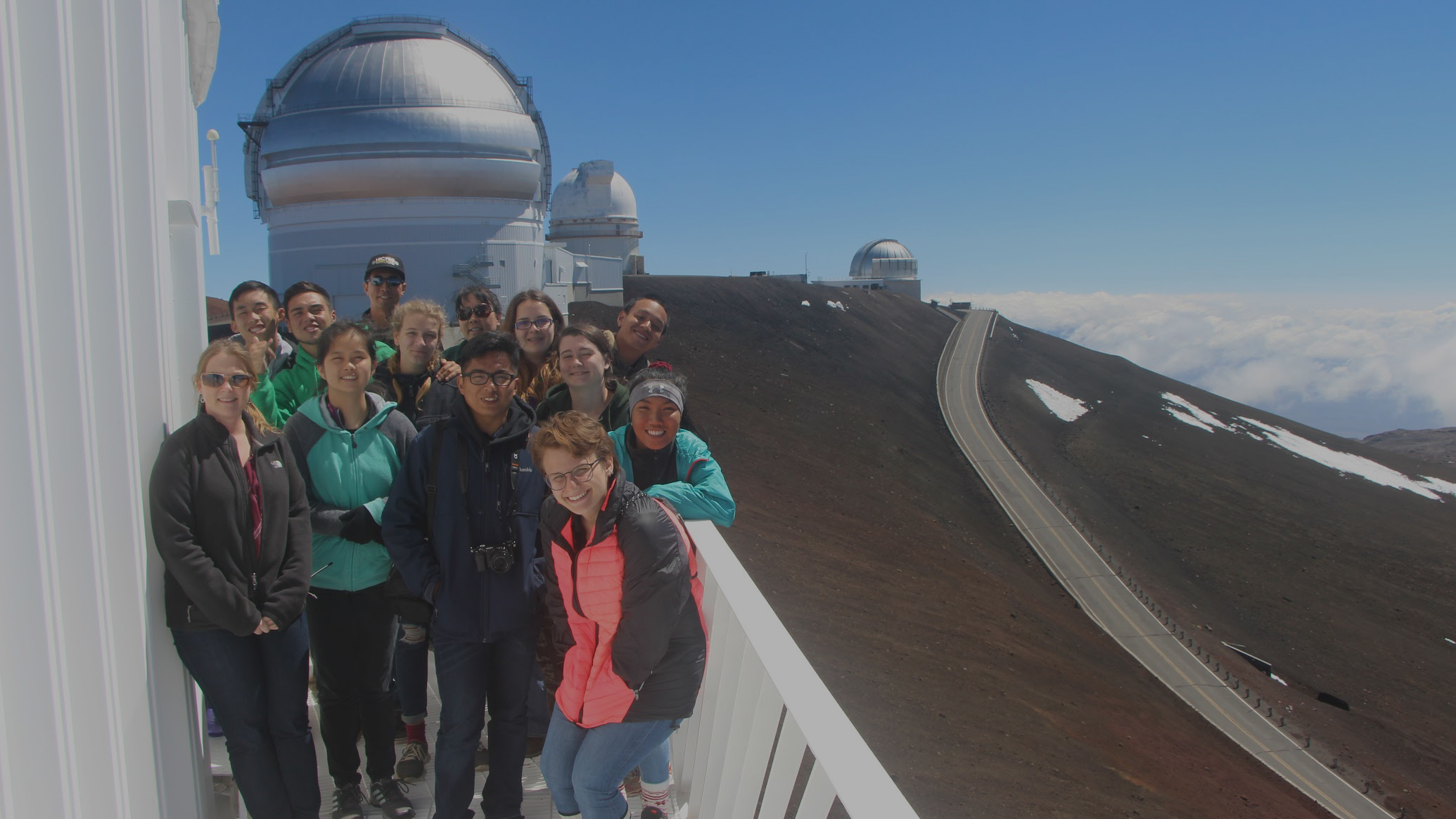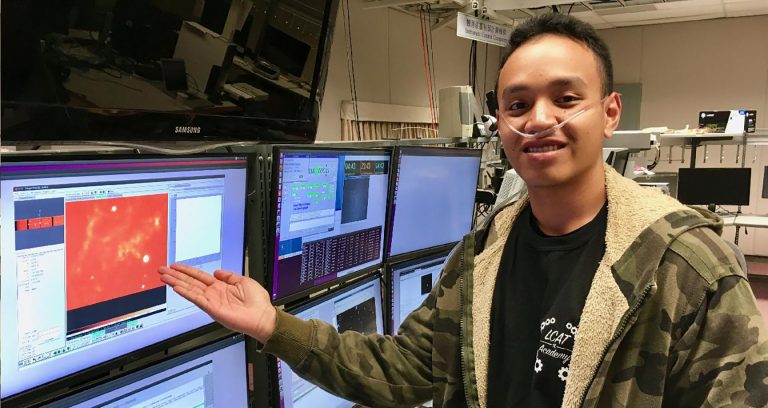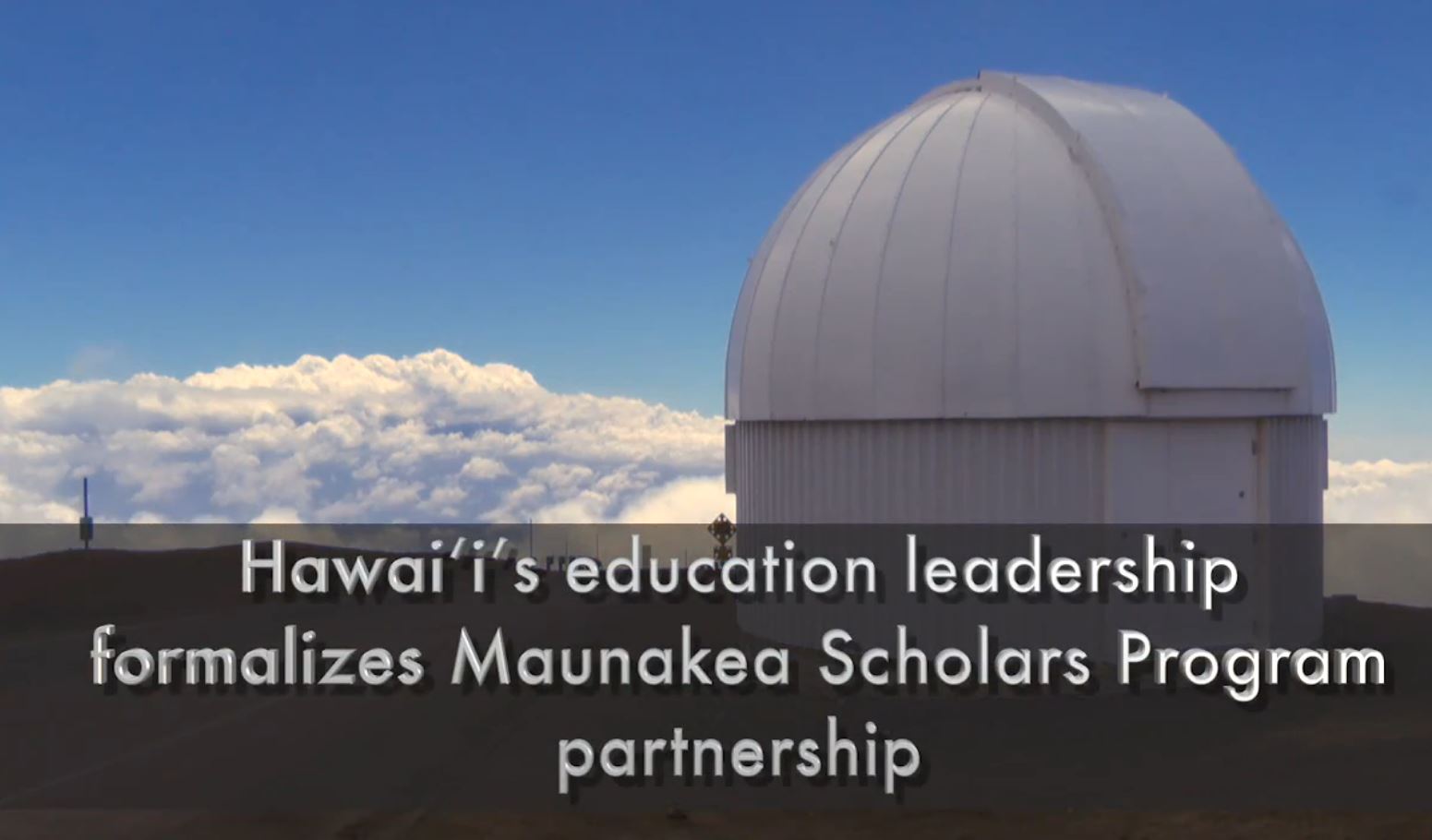Maunakea Scholars is an innovative program designed to bring Hawai'i's aspiring young astronomers into the observatory community, competitively allocating observing time on world-class telescopes, including the Maunakea Observatories, to local high school students. This lasting partnership between the Hawaiʻi Department Of Education, the University of Hawaiʻi, and the Maunakea Observatories (MKO), introduced in 2017, is the first program of its kind internationally, leveraging the most powerful collection of telescopes in the world for the direct educational advancement of Hawai'i's public high school students.



In addition to summit tours, a cultural component is offered by the ‘Imiloa Astronomy Center. For centuries, Native Hawaiians were expert astronomers and navigated their way to Hawai‘i using their profound knowledge of the stars. With astronomy having such a deeply rooted connection to Hawaiian culture, ‘Imiloa Astronomy Center grounds the program in a cultural context focused on Maunakea. This helps students understand the importance of Maunakea as a site revered across Polynesia for its cultural roots, and across the world as earth’s best portal on the universe.

Over 100 students have received telescope time since the start of the program.

From mentoring to awarding telescope time
The program includes school visits by program partners, and mentoring by University of Hawaiʻi Institute for Astronomy graduate students, who guide students writing proposals for MKO observations, and analyzing data from accepted proposals.
 Mentor Jessica Stasik and CFHT Director Doug Simons with Maunakea Scholar Dalton Saldana, part of a team observing Betelgeuse.
Mentor Jessica Stasik and CFHT Director Doug Simons with Maunakea Scholar Dalton Saldana, part of a team observing Betelgeuse.
 Justin Fernando from Kapolei High School on Oʻahu and his partner obtained time at Subaru to compare the spectra of a Type Ia and Type II supernova remnants.
Justin Fernando from Kapolei High School on Oʻahu and his partner obtained time at Subaru to compare the spectra of a Type Ia and Type II supernova remnants.

Issac Pauole and Jacob Pauole from Waiakea High School on the Big Island submitted a proposal titled “Jupiter’s Red Spot” and used the NASA IRTF to study Jupiter’s famous Great Red Spot.

The project "Spectroscopy of Hydrogen Rich Exoplanet Atmsopheres" by
Chantelle Lopez, from Kapolei High School on Oʻahu,
was awarded Gemini time with GNIRS to observe an exoplanet, compare
its spectra with a previous observation, and look for changes or weather.

Ryan Siarot and Thorren Rebugio from King Kekaulike High School on Maui were awarded time for their proposal “Observing Asteroid Colors to Determine Composition”. They used the Las Cumbres Observatory to compare the color of asteroids with known compositions to asteroids with unknown compositions to determine if asteroid color is a tracer of composition.
Growing Hawai'i's next generation of astronomers

Reaching out to all islands

In 2017, for the first time ever, the Maunakea Observatories reached the students of Molokai in the biggest way possible, telescope time on the Maunakea Observatories. CFHT Executive director Doug Simons, CFHT Director of Strategic Communications Mary Beth Laychak, and UH Institute for Astronomy Maui astronomer JD Armstrong visited Molokai High School to award telescope time to three students.
The latest addition to the Maunakea Scholars program is the Hōkūala (rising star) $10,000 Scholarship, awarded annually to one or more top-performing seniors in the program who are going on to study astronomy in college.

Keilani Steele from Honoka'a High School on the Big Island used the W.M. Keck Observatory to observe the Draco dwarf galaxy to map the galaxy’s rotation curve. She was the first two time awardee of telescope time in the Maunakea Scholars program, and the first recipient of the Hōkūala scholarship. She is now at UH Hilo.

"I have reviewed hundreds of scholarship applications over the years and know the great impact scholarships like this can have on students. It’s amazing to see how positively this can impact their lives."
- Doug Simons

Jean Claude Dumaslan from Waipahu High school on Oʻahu is the second recipient of the Hōkūala scholarship. He used CFHT to study luminous blue variable stars and their relation to Wolf Rayet stars.
"Being a part of the Maunakea Scholars program for two years was an amazing experience that helped me realize my passion for astronomy. Receiving this scholarship goes beyond anything I ever imagined, and I am so grateful to the Maunakea Observatories for supporting my astronomy dreams."
- JC Dumaslan
Mānoa Academy - University of Hawai'i
Since 2019, the program includes a college-level,
dual-credit, online Astro 101 course offered
through Mānoa Academy, free of charge.
Students who enroll get high school and college course credits,
allowing some of them to receive a college Associate's Degree before
graduating high school. The course is offered exclusively online, which allows
students from any of the Hawaiian islands to attend.
A cultural astronomy class was offered in Summer 2021. The
course covers the impact of astronomy on cultures throughout history
from Stonehenge and the Great Pyramids of Egypt to the thriving
astronomical practices today of the Maya and Polynesians. The course
content was developed through consultation with subject matter experts
in Mayan astronomy and with the support of the 'Imiloa Astronomy Center
in Hilo. It is critical to acknowledge the work of Kalepa Baybayan,
master Pwo Navigator and navigator in residence at 'Imiloa for his work
developing content prior to his passing in April.
Maunakea Scholars students visiting Honolulu for the AAS Winter Meeting. Teachers and students were welcomed by CFHT Director Doug Simons, Director of Strategic Communications Mary Beth Laychak and Mentor Jessica Stasik.

Visit our website! maunakeascholars.com
Email us! laychak@cfht.hawaii.edu




 Mentor Jessica Stasik and CFHT Director Doug Simons with Maunakea Scholar Dalton Saldana, part of a team observing Betelgeuse.
Mentor Jessica Stasik and CFHT Director Doug Simons with Maunakea Scholar Dalton Saldana, part of a team observing Betelgeuse.
 Justin Fernando from Kapolei High School on Oʻahu and his partner obtained time at Subaru to compare the spectra of a Type Ia and Type II supernova remnants.
Justin Fernando from Kapolei High School on Oʻahu and his partner obtained time at Subaru to compare the spectra of a Type Ia and Type II supernova remnants.



